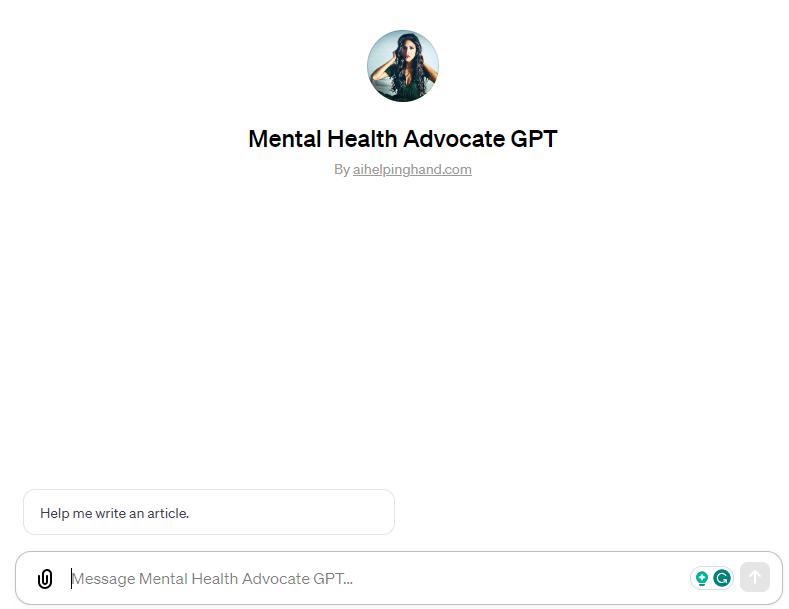Description
GPT Content Writer – ChatGPT 4 subscription is required to access.
Empower Your Voice: Transforming Mental Health Advocacy with Cutting-Edge AI Tools
As a Mental Health Advocate,
you understand the importance of conveying your message with clarity and compassion. That’s where this advanced tool steps in, designed to support and enhance your efforts as a Mental Health Advocate. It’s tailored to assist you in creating content that resonates and informs. This platform isn’t just about writing; it’s about empowering your advocacy with the right words and insights.
Our Mental Health Advocacy Writing Assistance provides an unparalleled level of support. From drafting initial outlines to the final touches of editing, this tool ensures that your articles, blogs, and guides reflect the depth and empathy of your mission. As a Mental Health Advocate, your goal is to reach out and make a difference, and with this tool, your words can achieve just that.
Incorporating the power of Mental Health Advocate AI,
this tool is more than a simple writing aid. It’s a dynamic companion that understands the nuances of mental health terminology and ethics. The AI is programmed to offer suggestions that are not only grammatically precise but also sensitive and appropriate for the topic at hand. It’s like having a knowledgeable Mental Health Advocate by your side, ensuring that your content is both impactful and respectful.
Moreover, the Mental Health Advocacy Writing Assistance feature is designed to help you connect with your audience more effectively. It helps in crafting stories that not only inform but also engage and inspire. Whether you’re addressing complex issues or offering support and guidance, your writing will resonate on a deeper level.
As a Mental Health Advocate, your voice is vital in the ongoing conversation about mental wellness. By utilizing this comprehensive tool with its Mental Health Advocate Tools and Mental Health Advocate AI, you’re not just enhancing your writing skills. You’re also strengthening your advocacy, reaching wider audiences, and contributing more powerfully to the important dialogue surrounding mental health. Let this tool be your ally in the noble cause of promoting mental wellness and understanding across communities. Together, we can create a world where mental health is discussed with the care, depth, and empathy it deserves.
Example: Help me write an article.
Results: (Based on a limited bit of information entered into GPT when requested.)
Understanding the Psychology Behind Bullying: Perpetrators and Victims
Introduction:
Across the United States, thousands of teenagers face the daunting challenge of bullying. This pervasive issue manifests in schools, online platforms, and social environments, significantly impacting the emotional and physical well-being of young individuals. Victims of bullying often endure fear, anxiety, and a range of mental health issues, with some cases tragically leading to suicide. This article seeks to delve into the psychology behind bullying, exploring the motives of perpetrators and the profound effects on victims.
Section 1: The Rise of Bullying in the Digital Age
The advent of social media has given rise to a new and insidious form of harassment: cyberbullying. Platforms like Facebook, Instagram, Twitter, and Snapchat have become arenas for spreading hurtful comments and rumors. Unlike traditional bullying, cyberbullying allows the perpetrator to hide behind a screen, often leading to relentless and pervasive attacks that follow victims everywhere they go. Understanding this modern twist is crucial in addressing and preventing bullying in today’s digital world.
Section 2: Unraveling the Mind of a Bully
To effectively combat bullying, we must first understand why some children resort to such behavior. Family life plays a significant role; children who witness or experience aggression at home may mimic these behaviors, exerting control over others to cope with their own feelings of helplessness. Peer pressure is another critical factor. The desire to fit in or dominate can drive children to ridicule others to establish their status within social hierarchies. Additionally, the media often glorifies aggression and power, subtly influencing young minds to view bullying as a means to gain respect and fear.
Section 3: Why Children Become Targets
Children can become targets of bullying for various reasons. Physical appearance, disabilities, race, sexual orientation, and even traits like intelligence and creativity can make them stand out. Lack of social skills or friends often leaves children vulnerable, as they lack the support network to defend themselves. Understanding these risk factors is vital in identifying and supporting those at risk.
Section 4: Psychological Impact on Victims
The consequences of bullying extend far beyond the immediate physical harm. Victims often suffer from anxiety disorders, chronic depression, and even post-traumatic stress disorder. Their physical health can deteriorate, leading to a higher risk of self-harm and suicide. Bullying erodes the ability to trust, making it difficult for victims to form friendships and relationships, and often leads to substance abuse as a coping mechanism.
Section 5: Conversations and Prevention
Preventing bullying requires open, honest conversations. Parents and educators need to discuss the importance of empathy and kindness with children. Schools should implement comprehensive anti-bullying policies and programs that encourage inclusivity and respect. Community efforts to raise awareness and provide support can create environments where bullying is neither acceptable nor overlooked.
Section 6: Seeking Help and Support
It’s crucial for victims and their families to know they’re not alone. Many organizations and resources offer support, counseling, and strategies for coping with the effects of bullying. Encouraging victims to seek help and speak out is a vital step in healing and preventing further abuse.
Conclusion:
Understanding the psychology behind bullying is a complex but necessary step in combating this pervasive issue. By addressing the root causes, supporting the victims, and fostering environments of respect and empathy, we can work towards a future where no child has to endure the pain and isolation of being bullied. Together, we can make a difference in the lives of thousands of children across the country.








Reviews
There are no reviews yet.